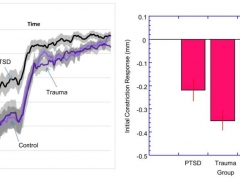How Do and Medication Change the Brain?
Psychotherapy
Source: TCPR, September 2010, Vol 8, Issue 9, The Neuroscience of Psychotherapy
Daniel Carlat, MD
Associate clinical professor of psychiatry, Tufts University School of Medicine
Disclosure
Learning Objectives
Financial Disclosure
We know that for many conditions, both medications and psychotherapy work about equally well. Common sense would dictate that there is some final common pathway of neuropsychiatric change underlying the symptomatic improvements we see. But identifying what is happening in a living human brain is extremely tricky. Recently, a number of articles have reviewed this topic, focusing on functional neuroimaging techniques such as positron emission tomography (PET)正电子断层扫描仪, single-photon emission computerized tomography (SPECT)单光子发射计算机断层扫描, and functional MRI功能磁共振成像.
In this article, I will give a simplified rendition of what we currently know about this topic. I emphasize “simplified” because this literature is about as complex and jargon-ridden as I’ve experienced in my seven years at the helm of this newsletter. I apologize in advance if I have oversimplified some findings in the service of translation to the clinician’s language.
Depression
While both cognitive behavioral therapy (CBT) and medications are effective for depression, it turns out that each treatment may be doing something quite distinct in the brain. Perhaps this should not surprise us, because we know that CBT differs clinically from medication in that it does a better job of suppressing future episodes of depression.
In one study, for example, depressed outpatients were randomly assigned to antidepressants or CBT. After 16 weeks, the response rates were nearly identical: 57.5% for meds and 58.3% for CBT. Next, the medication responders were randomly assigned to either medication continuation or switch to placebo, while all CBT responders stopped psychotherapy. One year later, medication patients who were switched to placebo (n=35) had a 76% relapse rate, patients who continued medication (n=34) had a 47% relapse rate, and CBT-only patients who stopped therapy (n=35) had only a 31% relapse rate. These results imply that a four-month course of weekly CBT prevents future depression recurrence better than a four-month course of meds (Hollon SD et al.,Arch Gen Psychiatry 2005;62(4):417–422).
CBT probably exerts this long lasting effect by giving patients coping skills that they can deploy over the years to control their moods. “Give a man a fish and you feed him for a day; teach a man to fish and you feed him for a lifetime.”
This much seems clear—but what about the underlying neurobiology of CBT’s effects? Researchers have focused on two main regions of interest: the prefrontal cortex (in charge of planning and executive functioning, and therefore presumably the portal through which CBT would exert its effects) and the limbic system (generally speaking, the emotional brain, encompassing the amygdala, the hippocampus, the cingulate gyrus, parts of the basal ganglia—and many other regions, as the official boundaries of the limbic system are often revised).
The first widely disseminated study to compare brain changes in CBT vs. meds focused on 13 depressed patients who responded to CBT versus nine patients who responded to paroxetine (Paxil). Patients who got better from CBT showed decreased metabolism in the frontal cortex and increased metabolism in limbic regions. On the other hand, patients who improved with paroxetine showed essentially the opposite pattern—increases in the prefrontal lobe and decreases in the limbic system (Goldapple K et al. Arch Gen Psychiatry2004;61(1):34–41).
The researchers believed that this data implied that depression is partly a problem with an excessively reactive limbic system, which gets too riled up in response to stress. Most studies have shown that depression correlates with hyperactivity in various limbic components, such as the amygdala, the hippocampus, and the cingulate gyrus.
In normal people (according to one theory), the prefrontal cortex dampens down limbic hyperactivity, but in depression it does not do its job properly. Perhaps the frontal cortex has become waylaid into one of several cognitive distortions, such as “catastrophizing,” meaning overinterpreting the significance of stressful events.
In order to treat this, you have to calm the cortex down and teach it to function more rationally. CBT is the preeminent method for directly achieving this. Therefore, it makes sense, as shown in the Goldapple article, that CBT would lead to lower metabolic activity of the frontal cortex, ie, less ruminating and less catastrophizing. This has been called the “top-down” solution to depression—that is, if you start by fixing your patient’s cortex, these changes will gradually work their way down to the limbic system.
On the other hand, it is presumed that SSRIs initially act directly in the serotonin-rich areas of the limbic system,where they calm down the limbic “storm” that correlates with depression. (Thus, paroxetine decreased activity in the limbic system in this study.) Since there is thought to be an inhibitory circuit between the limbic system and the frontal cortex, paroxetine’s calming of the limbic system disinhibits the frontal lobe, causing it to “wake up.” This is known as the “bottom-up” theory of how antidepressants work.
This all sort of makes sense—that is, until you read another study from the same research group published three years later. In this study, responders to CBT were compared with responders to venlafaxine (Effexor). This time, bothCBT and medication appeared to calm the frontal lobe. The researchers opined that this seemingly inconsistent result was due to the fact that this time they used venlafaxine (which inhibits the reuptake of norepinephrine in addition to serotonin), and that the length of medication treatment was longer (16 weeks vs. six weeks in the paroxetine study) (Kennedy SH et al., Am J Psychiatry 2007;164(5):778–788).
So maybe if you treat with medications long enough, the brain ends up looking like it has undergone CBT? It doesn’t sound extremely convincing, but it certainly sounds better in the discussion section than saying that they could not replicate their previous results, which would cast doubt on the validity of the initial findings.
Then, to make matters more complicated, another group of researchers interpreted these finding completely differently. Making a heroic attempt to synthesize a plethora of conflicting neuroimaging findings, they came up with the following idea (DeRubeis RJ et al., Nature Reviews Neuroscience 2008;9(10):788–796).
Depression is a disease of limbic hyperactivity leading to inefficient frontal lobe functioning. (In plain language, feeling depressed makes it hard to think clearly.)
CBT acts by increasing frontal lobe functioning. (While the studies I just described contradict this, the authors cited their own unpublished data in support of this statement.)
The fact that some studies show decreased frontal lobe activity after CBT treatment means that the lobe has been appropriately “reset” to give it greater reserve capacity to engage the newly learned cognitive skills in case they are needed to combat depression in the future. (This is presumably the reason why CBT is so good at preventing depression recurrence over the long term.)
Is your frontal lobe spinning? In another recent review of the literature on neuroimaging and depression, some Stanford researchers acknowledged that “these results…do not cohere to tell as clear a story as we would like” (Gotlib IH et al., Current Directions in Psychol Sci 2008;17(2):159–163).
Basically, we are witnessing the growing pains of a field of research still in its infancy. As with any new science, there are many pieces of seemingly contradictory data, and there will be many efforts to reconcile the inconsistencies.
One particular brain region deserves further mention here, because it has helped to put deep brain stimulation (DBS) on the map in psychiatry. The subgenual cingulate gyrus, also known asBrodmann area 25, or BA 25, is a little nubbin of brain tissue on the lowest part of the frontal lobe. In most functional neuroimaging studies, it is hypermetabolic in depressed patients and calms in response to medication.
Its true claim to fame is that it may be a crucial target in the treatment of refractory depression. In 2005, Helen Mayberg and colleagues reported “striking and sustained remission” in four of six patients with refractory depression, all of whom were implanted with electrodes to modulate BA 25 (Mayberg HS et al., Neuron 2005;45(5):651–660).
Paradoxically, when a DBS electrode stimulates tissue next to the hyperactive BA 25, the effect is to calm, or “modulate” it. In the dramatic initial reports, awake patients under local anesthesia in the operating room reported an immediate “lifting of the void” and a resolution of dread when BA 25 was stimulated. So far, a total of 20 patients with refractory depression have received this treatment, with a 60% response rate at six months (Lozano AM et al., Biol Psychiatry 2008;64(6):461–467). Placebo-controlled trials are apparently underway.
Obsessive Compulsive Disorder (OCD)
Thankfully, functional neuroimaging studies of OCD have been much more consistent in their results than those of depression. OCD is thought to be associated with hyperactivity of a neural circuit that comprises the orbital frontal cortex, the caudate, the thalamus, and the anterior cingulate cortex—meaning, essentially, that there is way too much communication between an over-worried frontal lobe and an over-active limbic system.
In a landmark study (the first ever to use functional neuroimaging in a comparison of medication with therapy), Baxter et al randomly assigned nine OCD patients to fluoxetine (Prozac) and nine patients to behavioral therapy. In the responders (six of nine patients in each group), both treatments led to similar PET scan findings: decreased metabolic activity of the anterior cingulate, the thalamus, and the caudate. Furthermore, the degree of reduced activity in the caudate was correlated with the degree of response (Baxter LR et al., Arch Gen Psychiatry 1992;49(9):681–689). Subsequent studies, while sparse, have been consistent with these findings (Frewen PA et al., Clin Psychol Rev2008;28(2):228– 246).
Social Phobia
Thus far, only one neuroimaging study has compared psychotherapy treatment with medication for social phobia. In this nicely designed study, 18 patients with social phobia were randomly assigned to cognitive behavioral group therapy (CBGT), citalopram (Celexa), or wait list control (six patients to each arm). All patients had pre- and post-treatment PET scans, and they actually had to deliver a speech to six observers while they were in the scanner.
Both the CBGT group and the citalopram group responded equally in terms of anxiety scores, whereas the wait list group showed no improvement. PET scans showed that, regardless of treatment, improvement in social anxiety was associated with significant reduction of activity in the amygdala-hippocampal regions—which was a nifty finding, since the amygdale is thought to be the region in which we evaluate the emotional significance of situations, and the hippocampus is our memory center (Furmark T et al., Arch Gen Psychiatry 2002;59(5):425−433).
Presumably, the successfully treated social phobics were no longer interpreting public speaking as scary, and were no longer retaining memories of panic. Rarely do neuroimaging results fit so neatly with our hypotheses of brain function.
See table 1 for a summary of the neurobiological effects of psychotherapy and medication.
Some Neurobiological Effects of Psychiatric Treatment: Therapy vs.Medication/Devices
| Treatment | Effect |
| Major Depressive Disorder 严重障碍 | |
| Cognitive behavioral therapy认知行为疗法 | Decreased activity in frontal cortex and increase in limbic region (Goldapple et al.;Kennedy et al.)额叶皮层活性下降,皮层边缘区活性上升 |
| Paroxetine (Paxil)帕罗西汀 | Increased activity in frontal cortex and decrease in limbic region (Goldapple et al.) 额叶皮层活性上升,皮层边缘区活性下降 |
| Venlafaxine (Effexor)文拉法辛 | Decreased activity in frontal lobe and variable in limbic region (Kennedy et al.) |
| Deep brain stimulation大脑深度刺激 | Decreased activity in Brodman Area 25 (subgenual cingulate gyrus) (Lozano et al.) |
| Obsessive Compulsive Disorder 强迫症 | |
| Fluoxetine (Prozac)氟西汀 | Decreased activity in anterior cingulate, thalamus, and caudate (Baxter et al.) |
| Behavioral therapy行为 | Same as above |
| Social Phobia 社交恐惧症 | |
| Cognitive behavioral group therapy 认知行为团体治疗 | Decreased activity in amygdala‐hippocampal regions (Furmark et al.) |
| Citalopram (Celexa) 西酞普兰 | Same as above |
See text for full references
Source: TCPR, Volume 8, Issue 9, September 2010, The Neuroscience of Psychotherapy
TCPR Verdict:
We have a long way to go before we understand the neurobiology of psychiatric disorders, but functional neuroimaging is at least making it clear that psychotherapy is as much a “neurological” treatment as a “psychosocial” treatment.






